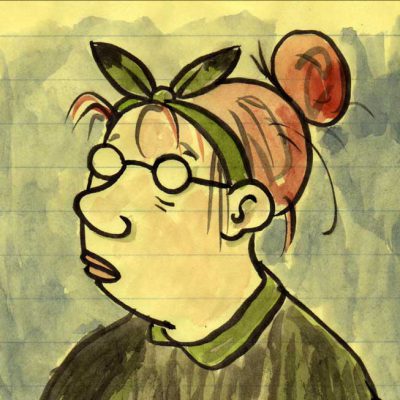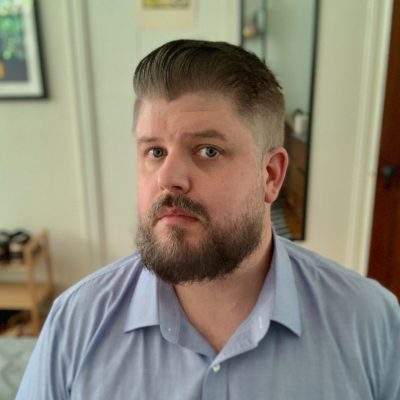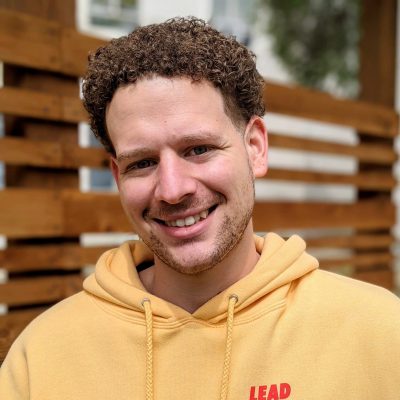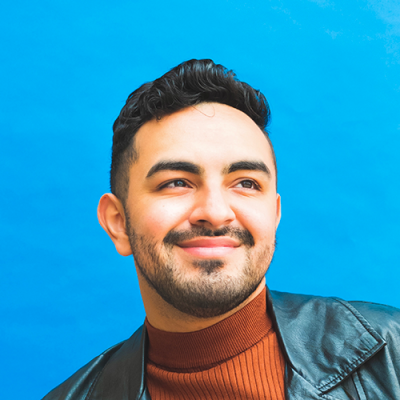Episode notes
Lynda Barry is a legendary comic strip author whose Ernie Pook’s Comeek has run for many years in alternative newspapers around the country. Her two most recent books, What It Is and Picture This are about writing and creating art, respectively. The former won an Eisner Award, comics’ most prestigious prize. The books take the form of a notebook, filled with text, collage and drawings. The content is based on a series of seminars Barry has taught on getting creative work done. In our interview, Barry talks with Jesse about activating the brain and the benefit of doing creative work that doesn’t need to fall into the dichotomy of beautiful/not beautiful, good art/not good art, or being productive/being nonproductive.
JESSE THORN: It’s The Sound of Young America, I’m Jesse Thorn. My guest on the program is Lynda Barry. She’s one of the nation’s most accomplished comics artists, graphic novelists, comic strip writers, artists, etc. etc. Her comics have run in alternative newspapers across the country for many, many, many years and more recently she’s turned much of her time towards writing longer works. Her book of just a couple of years ago, What It Is, was about the process of writing, and her latest, Picture This, is about the process of making art. They’re beautiful multimedia comics collage works that, as I said, are about process.
Lynda Barry, welcome to The Sound of Young America.
LYNDA BARRY: I’m delighted to be here.
Click Here for a Full Transcript.
JESSE THORN: It is a pleasure to have you here, Lynda. Describe, if you could to me, because I did a lousy job, the form of the two most recent of your books.
LYNDA BARRY: I wanted to make two books about something I call an image, and my teacher called an image, which is the thing that she said was contained by anything we called the arts. So the first book I talk about it by using writing, and the second one I talk about it by using drawing.
When I was writing the one about writing I didn’t want to just do writing about writing. It feels a little bit like you’re in a mirror maze or something. I wanted to make it so that the person who was reading it didn’t even know why they were getting the urge to make something. The same thing for the new book Picture This. I wanted it to be about drawing but without any instruction on how to draw. I just wanted to make it so that when you started to flip through the pages you just had this itchy urge to make something, and I wanted to make both those books completely by hand and to use stuff that you could just get at the corner store. They’re all made with scissors and Elmer’s Glue and some paper from the trash. That’s what I wanted to do. My goal was to make it so, for this book – – remember when you were at the dentist when you were a kid they had this magazine called Highlights for Children.
JESSE THORN: Featuring Goofus and Gallant.
LYNDA BARRY: Yes. It was not a great magazine. It was not very good, but you were in a tense situation, which was the dentist. You had Goofus and Gallant and find the hidden whatever. I thought to myself I wanted to make an equivalent of that for an adult, and the thing I pictured was a Jiffy Lube waiting room when you have to go get your – – when you’re in there, even if it’s an old, old People magazine from years ago with Tom Selleck on the cover you were so grateful. So I wanted to make a book – – I kept picturing it in the Jiffy Lube waiting room. It’s a book you can open anywhere and move through like a magazine, and to make it so that it’s not an intimidating art book and if you just want to look at it and say, “I could do that,” and then close it, well done.
JESSE THORN: What are the images that come to your mind when you think of drawing as a kid; drawing preadolescent for you, personally.
LYNDA BARRY: First of all, scribbling is one thing that comes to mind that I really remember. My big breakthrough that actually might be the first drawing that I ever sold – – I knew my Playboy bunnies, so I would draw these girl bunnies in little bathing suits, and then I started just leaving the bathing suits off. I would sell them, and I got busted for doing it. But really there was just something that was really wild about being able to, with a crayon or with a piece of paper make this picture that was contraband or kind of exciting or wrong. Which is really an interesting thing, crayon, piece of paper, and then this third thing that happens, this image and it makes your body feel a certain way, whether it’s scared or excited.
Then what happened in me is what happens to everybody, there’s this point when you realize you’re not that good at it. There’s a feeling where unless we’re really good at something we don’t have the right to do it, we have to leave it to professionals. What I got interested in was a study that was done about the brain and about what parts of the brain are activated when a kid is in deep play, and by deep play what I mean is where the toys playing back with you. And then also what an adult brain looks like when an adult is in creative concentration, and their brains looked identical. It was an activation of the entire brain, the limbic system and all your spatial relationships and balance. I put together this thing about what we all know about playing, what everybody knows around the world, is if you have a kid and you give them everything they need except they’re never allowed to play until they’re 21, we know they’re going to be crazy. Everybody knows that, which means we have a tacit understanding between the relationship of play and mental health. For a kid – – we’re going to have this experimental kid, never allowed to play. What if we just show him a picture of a kid playing LEGO, that’s not going to do it. Watch a DVD, that’s not going to do it. That’s not going to serve that function, and that’s where we are as adults for the most part, we just watch or look at a picture or listen to a DVD.
JESSE THORN: When it comes to art, it seems like the dichotomy that develops when the creation of art stops being just a sort of freeform play and when it starts having objective is between beautiful and not beautiful, and that’s sort of the good and bad of art and not art. How did you experience that dichotomy when you were becoming self-aware in your art when you were 10 or 11 or 12?
LYNDA BARRY: There is a point in cognitive development where you can tell that the char that you’re drawing doesn’t look like the chair that’s sitting across the room, but more importantly anyone else in the room can tell that. And then people get ashamed and inhibited, and then the whole point is to make something that is pleasant to look at, but that also includes heavy metal monsters; those can be really pleasant to look at.
JESSE THORN: I remember drawing a lot of side views of airplanes because I just have that outline with the little tail fin and then a wing. You know, the direct side view of a wing.
LYNDA BARRY: Do you still draw that every now and then?
JESSE THORN: Yeah, from time to time I’ll draw an airplane. Absolutely.
LYNDA BARRY: I think that almost all adults that quit drawing still have a little thing that they doodle or draw. Particularly if they’re in a situation that involves having to listen to something very boring, or to wait on the telephone for the cable man to pick up. When people say I can’t draw, I say what do you draw when you’re at a bad meeting? And they’ll say they draw eyeballs, or you, you draw the side view of the plane. There’s something about drawing that that makes a boring situation tolerable. Why? That’s really interesting to me. I’m convinced it’s because it actually activates a different part of the brain.
JESSE THORN: It’s The Sound of Young America, I’m Jesse Thorn. My guest is the comics artist Lynda Barry. Her new book is called Picture This. It’s a book of collage and art and comics and all kinds of stuff about the process of creating art. It’s a follow-up to her best selling book What It Is, which was a similarly formatted book, largely about writing.
When you were a freshman and sophomore in college before you met the woman that became your mentor and taught you some guiding principles that are reflected in these books, what kind of art were you trying to make?
LYNDA BARRY: I was making a lot of drawings of – – I really liked the Art Nouveau style, so I was copying a lot of Art Nouveau, I liked the way those curves went. I didn’t think I should study art, because I – – I went to a hippie school for one thing.
JESSE THORN: Evergreen.
LYNDA BARRY: The Evergreen State College in Olympia, Washington. Art was something I already knew how to do, so I should study something I hated so I’d my money’s worth. It took me two years to figure out that I should really pursue this thing that actually soothed me and really brought me a benefit. The first year I studied the history of science, which I loved. The second year I studied the history of the middle ages and the renaissance, I liked history.
JESSE THORN: What did you learn when you started studying art in college and met your mentor, and how did what you learned change your life and your way of doing your work?
LYNDA BARRY: For one thing it was a very unusual – – it was an images class, so there were sculptors painters and photographers in the class, and people who drew, and there were only 20 of us. My teacher Marilyn Frasca, her idea was that there is no difference between looking at a picture, making a picture, writing a story, that it’s all about this state of mind, the serial state of mind. I wish she had told me that earlier on, then I would have had a bigger clue.
In order to be in her class we had to do ten finished paintings a week, we had to write five pages a day, we had to memorize poems, and we had to learn how to look at pictures; for instance, the critiques in her class, when somebody would put up their work and nobody was allowed to say anything. We just had to learn how to look at something for 15 minutes and then it got longer to where it was an hour. That will get the frame of mind I was talking about, the thing where you go from looking at something and knowing what it is, to being very bored, to finally the picture looking back at you, where it’s reciprocal.
JESSE THORN: All of the things you’re describing right now, I genuinely feel scared. Just hearing you describe them scares me.
LYNDA BARRY: Because?
JESSE THORN: It’s more than I can handle.
LYNDA BARRY: You mean just sitting and looking at something?
JESSE THORN: Yeah, absolutely. Or making almost anything.
LYNDA BARRY: The trick is – – the kind of making I’m talking about is tracing your hand and making it a turkey. See? That makes you happy, even just thinking about that.
JESSE THORN: Yeah, sure. Turkey is a great animal, for one thing. They’re really stupid and fat.
LYNDA BARRY: And you can draw them pretty easy with your hand, put a beak on him, give him a little cigarette, which will spice up any drawing.
JESSE THORN: Art tips with Lynda Barry.
LYNDA BARRY: Just you imagining it, and I saw how you looked and you smiled, something happened in your body right then. People are out on the street trying to buy illegal drugs to make that thing happen. When I talk about this having a biological function I don’t mean it as a metaphor, I mean direct. If you make something thinking about that that’s the thing you’re looking for, that sensation that you had when you thought of tracing your hand to make a turkey, that’s what we’re after the drawing of the turkey doesn’t matter. It’s not that it doesn’t matter, I hate that. It’s not that, it’s more like getting this feeling of what an image feels like. And Marilyn’s idea was once you understood what it feels like, like the serial, the form you give it is up to you. I was convinced by the end of the two years I studied with her that I could do anything; whether it was writing a novel, or making a painting, or doing a comic strip, or making a play. It turns out I do feel like I can do anything.
JESSE THORN: Let me ask you this question. I myself am the kind of person that’s really great and figuring out all the flaws in a plan.
LYNDA BARRY: You mean before it even happens?
JESSE THORN: Sure, of course! To my credit I’m also pretty good at addressing them when I figure them out. What I wonder is, what is the process that you use to take this play space and use it to generate something that you do care about after you’ve done it, a picture of a turkey that you want to keep and not throw away?
LYNDA BARRY: It has to do with having an experience. For me, one thing that’s vital is that I kind of don’t know what the thing is going to be about, but I do know, for example, if it’s a piece I’m going to write I like to know how long I’m going to be writing for or how long the piece is going to be. The way I set up my writing class and the way I do it myself is I just have this big bag of index cards with nouns on them, and sometimes gerunds or -ing words, and I have everything set up ready to go, maybe it’s going to be a four panel comic strip, I have those drawn. And then I have to swear that whatever word I pull out, that’s the word the strip is going to be about.
The same thing for drawing. A lot of times if I’m going to sit down and draw and I say I think I want to draw Marlys running down the road, before I do that I do the alphabet with my brush, very slowly. There’s something about being in motion, that once the brush itself, or moving your hand around, that will get that part of the brain activated and ready to draw. I don’t think a computer does it the same way, because a computer you can’t forget the fact that you have a delete button. I always say if I had that on my life I’d only have 27 minutes, maybe, that I’d keep. There’s something about writing by hand or drawing by hand, the hand in motion. There’s lots of interesting science behind that, too. There’s something about hand movement, even while I’m talking to you right now, I know we’re on the radio, but I can’t talk without moving my hands a lot. They’ve done studies about that where they make people hold their hands still and they have a harder time expressing themselves. I think there’s something about the motion of the hand and our beautiful opposable thumbs that is really connected to whatever this art world is, whatever the image world is. All I have to do is get my hands in motion and have a shorter amount of time to work than I think I need.
JESSE THORN: One of the things that I often end up talking to comics artists about is the seclusion that is almost inherent in being a comics artist. I remember talking to Dan Clowes about the fact that he just talks to his dog like his dog is a person because he just doesn’t have anyone else to talk to up in his attic where he does his work. You seem to have ensured that for yourself by moving to a farm in Wisconsin. You seem like a reasonably social person, how do you like the experience of being isolated and how does it relate to you doing your work?
LYNDA BARRY: I never really feel that alone. I don’t feel isolated, because I think that would have to involve a loneliness feeling or something. My characters are really alive to me, and actually one night after I’d been out with pals at a bar I was lying in bed and all of a sudden I realized I was never gonna meet Marlys and Arna and I started crying, I was so sad. Then the next morning I realized it wasn’t that sad, I was just sort of drunk. But I never feel like I’m alone out there, and the part of it is that image world. If I was going to be alone for a month straight not even seeing someone else, that wouldn’t be a problem for me. Except for I would miss my husband very much, and my dogs.
JESSE THORN: Lynda, thank you so much for taking all this time and being on The Sound of Young America.
LYNDA BARRY: I’m delighted to be there, and I hope you will take the time to trace your hand. You, yes you, I’m talking to you, trace your hand and draw a turkey, and put a little hat on it, and then give it a cigarette, and then have it saying something to someone that you hate. See, you feel better, right?
JESSE THORN: Okay, how about this: I will do this and then I will also scan it into the internet, I’ll post it on our forum in the discussion thread about this show when it comes out, except that the only thing is I’m going to leave out the thing that I would say to someone that I hate because I don’t want to put that in public.
LYNDA BARRY: It can be someone in history! Someone who’s gone! Or whatever you want. But I just like how when I said someone you hate you lit right up. I think hate has been given a bad name.
JESSE THORN: Thanks again. Lynda Barry is the author of picture this, a book all about the process of creating art and how you can create art in myriad forms, both you can create art in myriad forms and the book takes myriad forms. It’s the follow up to another wonderful book called What It Is, about writing.
In this episode...
Guests
- Lynda Barry
About the show
Bullseye is a celebration of the best of arts and culture in public radio form. Host Jesse Thorn sifts the wheat from the chaff to bring you in-depth interviews with the most revered and revolutionary minds in our culture.
Bullseye has been featured in Time, The New York Times, GQ and McSweeney’s, which called it “the kind of show people listen to in a more perfect world.” Since April 2013, the show has been distributed by NPR.
If you would like to pitch a guest for Bullseye, please CLICK HERE. You can also follow Bullseye on Twitter, YouTube, and Facebook. For more about Bullseye and to see a list of stations that carry it, please click here.
Get in touch with the show
People
How to listen
Stream or download episodes directly from our website, or listen via your favorite podcatcher!





